Maths Grade 2 Topics and Worksheets
4 – Digit Numbers |
|
|
Thousands, Hundreds, Tens and Units – 4 Digits (Blocks):
Thousands, Hundreds, Tens and Units. |
Reading and Writing Numbers – 4 Digits:
Set 1 – Writing from words to numbers and from numbers to words. Click here for Set 1
|
| Using an Abacus for 4 Digits:
Writing the numbers shown on each abacus. |
Comparing Numbers:
Comparing Numbers using sign “<” or “>”
|
4 – Digit Numbers |
|
| Using an Abacus for 5 Digit Numbers
Writing numbers shown on abacus and how to place beads on an abacus to represent numbers. |
Rounding to the nearest 10 and 100:
Rounding off numbers to nearest 10 for example 183 would be 180 and rounding off to the nearest 100 where 183 would be 200. |
| Reading and Writing Numbers 5 Digits:
Reading and writing numbers in words. |
Putting Numbers in Order
Putting the numbers smallest to largest |
| Place Value: 5 Digit Numbers: Placing values of 5 digit numbers. Like in 23467 the number 3’s value would be 3 thousand. 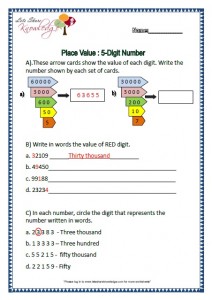 Click here |
|
Addition |
|
| Adding Numbers Renaming
Renaming of number means using Units, Tens Hundreds, Thousands and so on for addition purpose. |
Adding 3 Digit Number
No renaming means not using Units, Tens, Hundreds and so on for addition. |
| Adding 4 Digit Numbers: No Renaming
No renaming means not using Units, Tens, Hundreds and so on for addition. |
Adding 3 Numbers
Adding 3 numbers would be |
Subtraction |
|
| Subtracting 4 Digit Numbers: No Renaming: Crossing out beads on the given abacus, subtracting the numbers and writing the difference between the given two numbers. 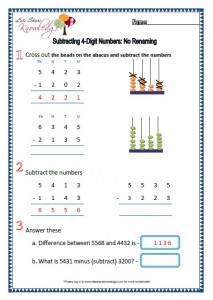 Click here Click here |
Subtracting 3 Digits Numbers: With Exchange: Subtracting the given numbers, Writing which two numbers have a differnce of the given number in question and filling in the blanks with numbers 1, 2, 3, 4 or 5. 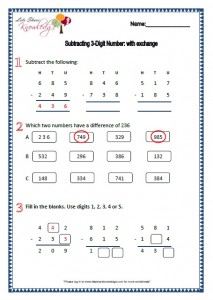 Click here Click here |
| Subtracting 4 Digits Numbers: Renaming: Subtracting the given numbers, solving the problems and writing the difference of given numbers. 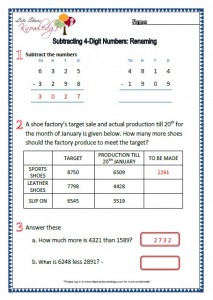 Click here Click here |
|
Properties and Patterns of Numbers Worksheets |
|
| Number Properties and Pattern: Writing the numbers given on the scale which are ointed by an arrow, writing the missing numbers in sequence and writing the numbers which are halfway between the two numbers.
|
Counting 10’s, 100’s and 1000’s: Looking at the abacus and stating the addition or subtractions of 10’s, 100’s or 1000’s, then writng the next three numbers in a given pattern and lastly writing the missing numbers based on a sequence.
|
| Even and Odd: Sorting out the even and odd numbers. Circling the smallest or biggest even or odd numbers and colouring the blocks yellow having most of either even or odd.
|
Number Pattern: Writing the next two numbers in the given number pattern.Writing the missing numbers in each sequences and making a 5 number sequence.
|
| Patterns and Problems: Counting in groups and writing
|
|
Time Worksheets |
|
| Time: Writing the months in order, completing questions and choosing the correct answers based on minutes, hours, days, weeks, months and years.
|
Minutes Past Hour: Writing the time on the clocks as minutes past the hour. Drawing the given time on the clock face and showing the time on the clock faces.
|
| Reading the Time: Write the time on the clock faces in numbers and in words. Write the time given on the clock faces. What is the difference in time? Time problems.
|
Calendars: Answering questions by looking at the Calendars.
|
| Time Problems: Writing timings, answering questions based on time schedule given and solving problems based on time.
|
|
Multiplication Worksheets |
|
| Multiplication Facts: Random questions based on multiplication.
|
Multiplying by 9: Practice questions on multiplication by 9.
|
| Multiplying by 6: Practice questions on multiplication by 6.
|
Multiplying by 10 and 100: Practice questions on multiplication by 10 and 100.
|
| Multiplying by 7: Practice questions on multiplication by 7.
|
Multiplying Multiples of 10: Complete questions like 5 * 10 = 50, and word problems.
|
| Multiplying by 8: Practice questions on multiplication by 8.
|
TU * U No carrying: Multiplication sums and Filling in the correct signs ( <, =, >).
|
| TU * U with carrying: Multiplication and using different digits to get answers.
|
|
Division Worksheets |
|
| Division: Grouping: Grouping into numbers given and word problems.
|
Numberlines: Using numberlines to answer questions.
|
| Division: Repeated Subtraction: Solving questions based on division with repeated subtraction.
|
Division without remainder: Division sums without remainder like 10 divided by 5 equals 2 and few word problems.
|
| Division and Multiplication: Questions based on multiplication and division.
|
|
Angles |
|
| Angles and Turnings: Writing directions in which the arrow will turn, clockwise or anti clockwise.
|
Right Angles: Questions based on understanding right angles.
|
| Types of Angle: Writing the names of angles formed, telling what angle is the birdie’s beak showing and drawing line segments.
|
Angles and Shapes: Writing the names of angles formed, telling what angle is the birdie’s beak showing and drawing line segments.
|
Symmetry |
|
| Symmetry: These worksheets are about drawing the reflection of each shape, drawing lines of symmetry and circling the alphabets where the line of symmetry cannot and where it can be drawn.
|
Symmetrical Shapes: These worksheets are about drawing another line of symmetry, drawing two lines of symmetry and telling Which of the shapes do not have at least 2 lines of symmetry? Circle it. Draw 2 lines of symmetry for the other.
|
Shapes |
|
| Squares and Rectangles: These worksheets are about drawing squares and rectangles.
|
Triangles: These worksheets are based on different kinds of triangles, like isosceles, right angled etc.
|
| Drawing Shapes: These worksheets are about drawing shapes based on given measurements.
|
Naming Solid Shapes: These worksheets are about naming solid shapes like cone, cube, sphere etc.
|
| Faces of Shapes: These worksheets are about identify how many faces does a shape has and questions related.
|
Properties of Shapes: These worksheets are about properties of shapes like knowing about an edge, side or a face.
|
| Nets of Shapes: Naming the 3D shapes, colouring squares to complete the net of 3D shapes and answering if the given diagram is a net of a 3D shape.
|
|
Functions |
|
| Inverse Relations Addition and Subtraction: Completing the equations and making addition and subtraction equations.
|
Equation and Equalities: Using the correct signs (<,=,>), putting numbers in the box to correct the statement and filling in the given numbers to complete the equations.
|
| Inverse Relation Multiply and Divide: Basic Multiplication and Division questions.
|
Missing Numbers: Completing the missing numbers. Solving the equations.
|
Measures |
|
| Measuring Length: Using the correct sign (<,=,>), converting like from meters to centimeters
|
Estimating Length and body units: Measuring lengths using hand spans, converting measurement to centimeters and comparing the found out measurements.
|
| Measuring Weights: Using the correct signs, converting like kg to grams and matching the given numbers.
|
Measuring Capacity: Converting like litres to millilitres, choosing the correct sign (<,=,>) and matching.
|
| Measuring Problems: Writing the total weight, questions on how much ml required and solving problems.
|
|
Perimeter and Area |
|
| Perimeter of Shapes: Finding the Perimeters of the shapes given. Drawing the shapes based on the measurements given. Answering which of the shapes have greater parameter.
|
Perimeter of Rectangles and Squares: Finding the perimeters of the rectangles and squares. Colouring the parameter of the shapes that is asked.
|
| Areas of Shapes: Finding the areas of the shapes given. Colouring to make areas as asked and writing the approximate areas of the figures.
|
Area of Rectangles: Finding the areas of the rectangles given. Coloring the areas as asked, and finding the areas of the given measurements.
|
Fractions |
|
| Numerators and Denominators: Writing the fractions. Answering what fractions are coloured and colouring the fractions asked.
|
Fractions on Number Lines: Answering what fraction is the number line showing. Marking the fraction given.
|
| Comparing Like Fractions: Writing the same fractions. Crossing the smallest and circling the biggest fraction. Drawing and colouring a like fraction.
|
Fractions of Numbers: Circling based on fraction asked. Solving fractions and answering problems.
|
| Adding and Subtracting like Fractions: Adding, subtracting and matching the fractions.
|
Fractions and Money:
|
Handling Data |
|
| Pictograms: Answer questions based on the pictogram given.
|
Bar Graphs Different Scales: Giving answers of the questions based on the bar graph given using different scales.
|
| Bar Graphs: Giving answers to questions based on bar graphs.
|
Probability: To find if the event is likely, unlikely, certain or impossible. Circling the correct answers and drawing based on the probability asked.
|
| Even Chance: Finding out about less than even chance, even chance and more than en chance of things in the questions asked. Completing pictures to make the statements true.
|
|


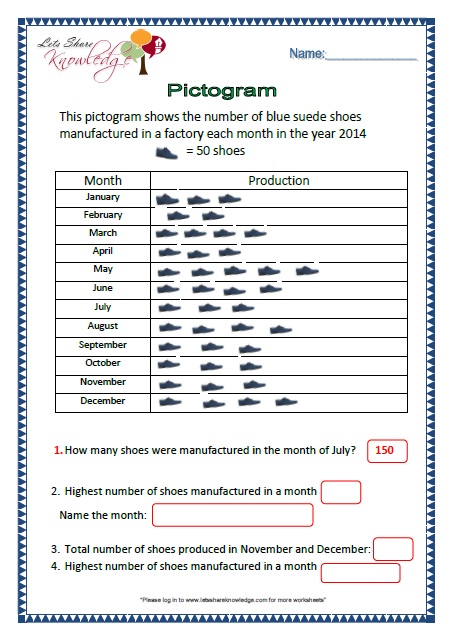
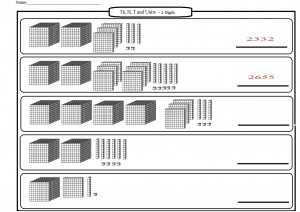
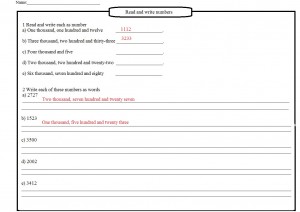

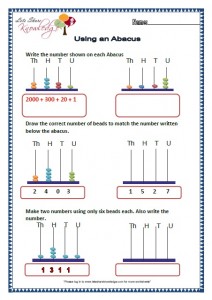
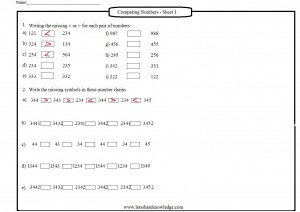
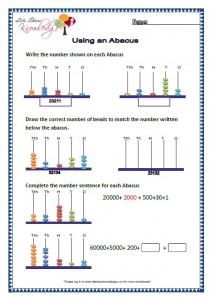
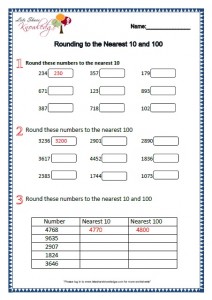
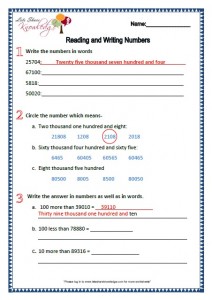
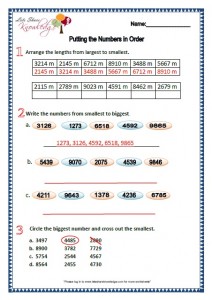
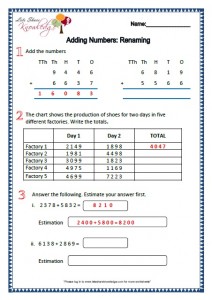
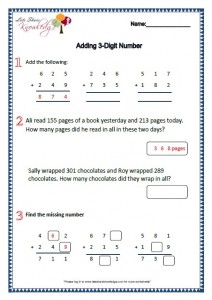

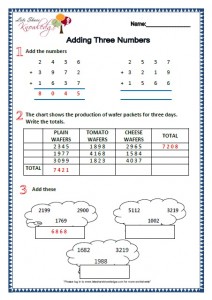
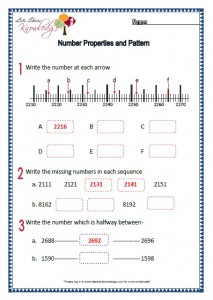
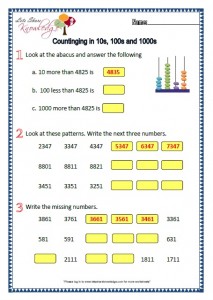
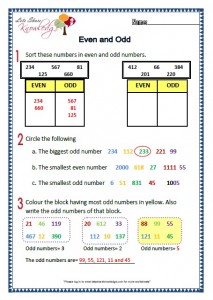
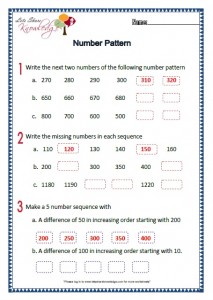
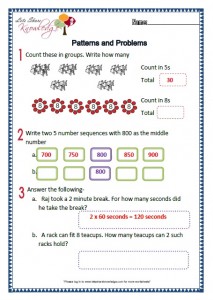
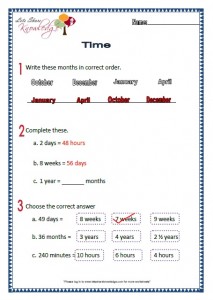
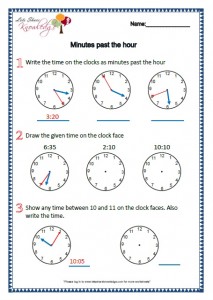
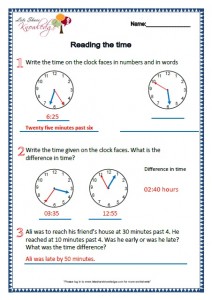
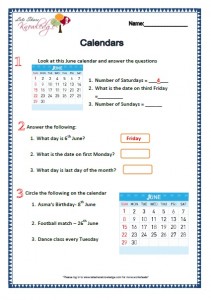
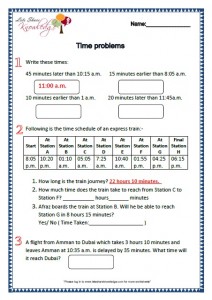
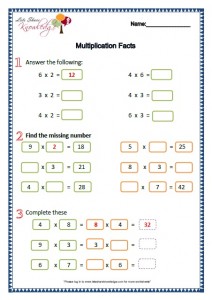
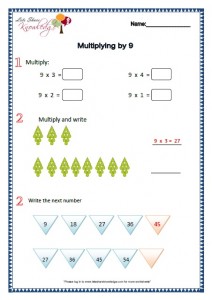
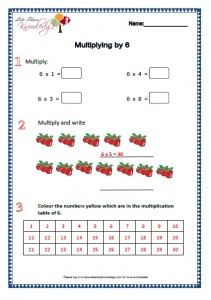
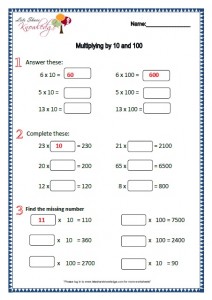
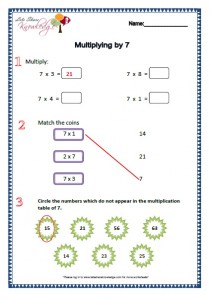
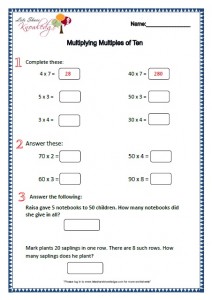
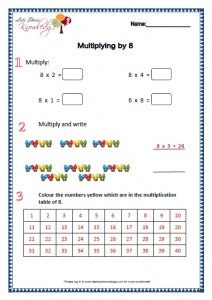

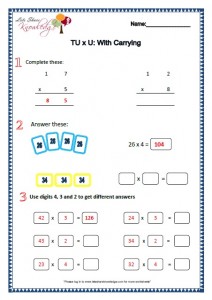
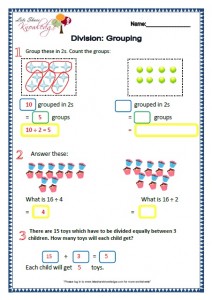
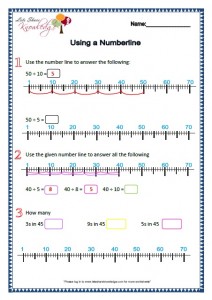
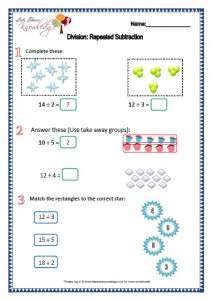
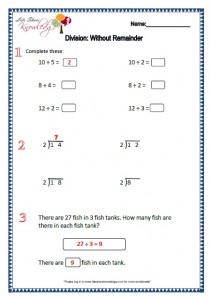
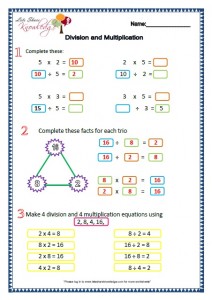
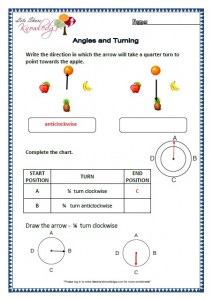
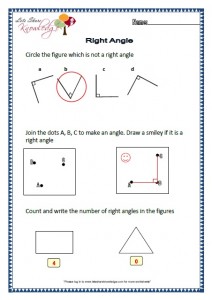
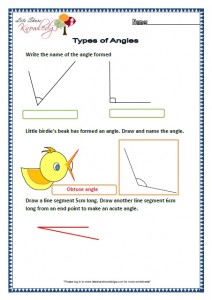
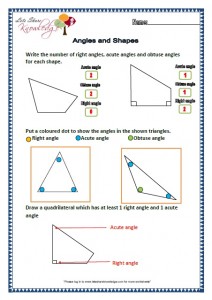
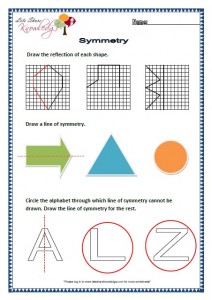
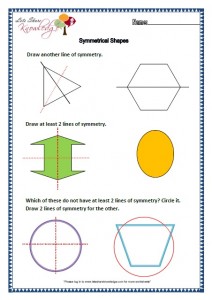

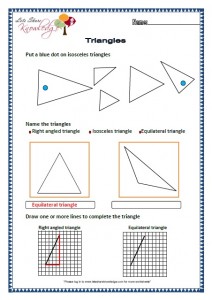
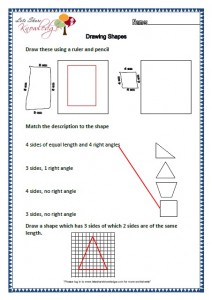
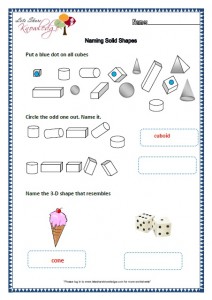
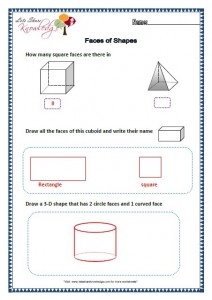

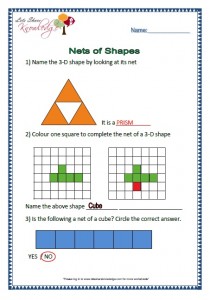

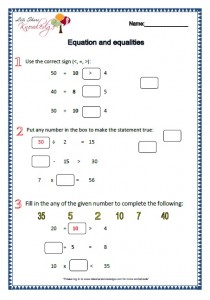
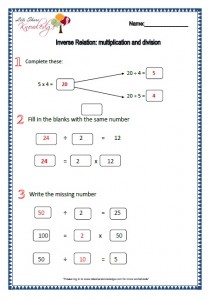
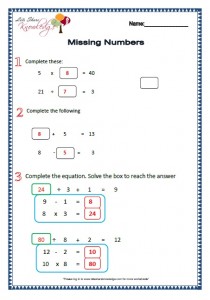
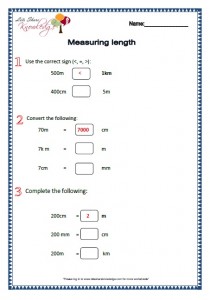
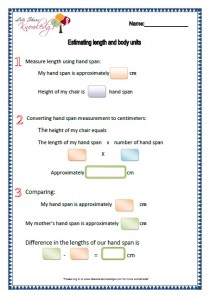
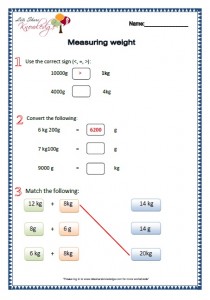
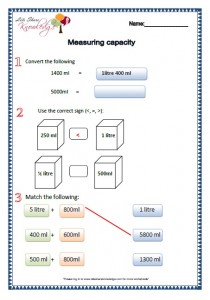
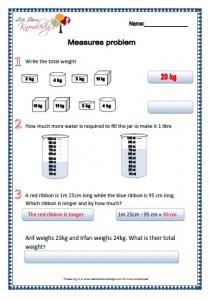
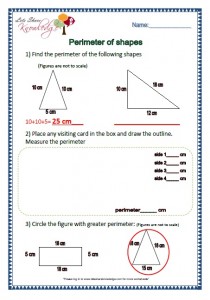
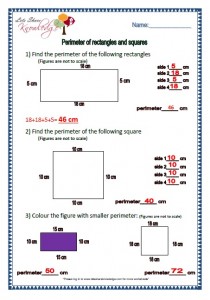
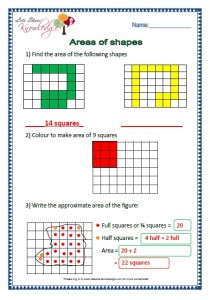
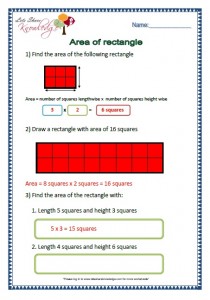
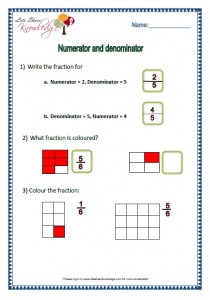

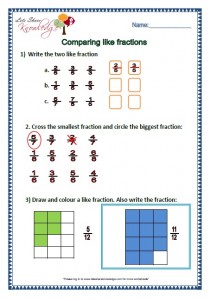
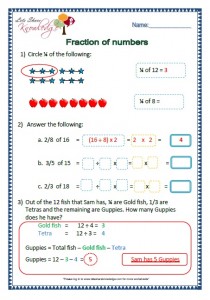

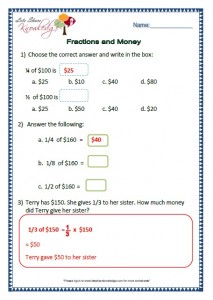
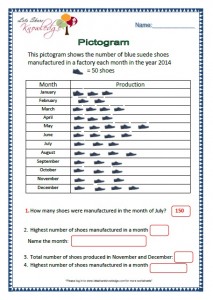
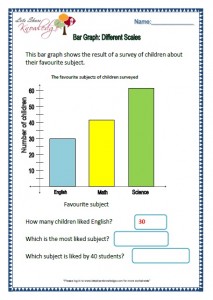
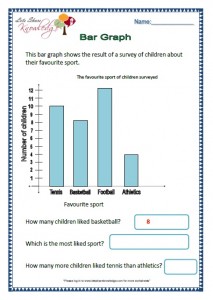
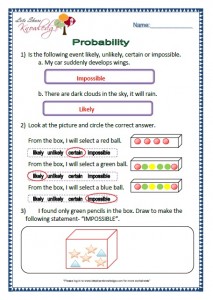
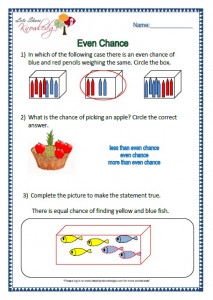




Yes my objective is to cover as much as I can.